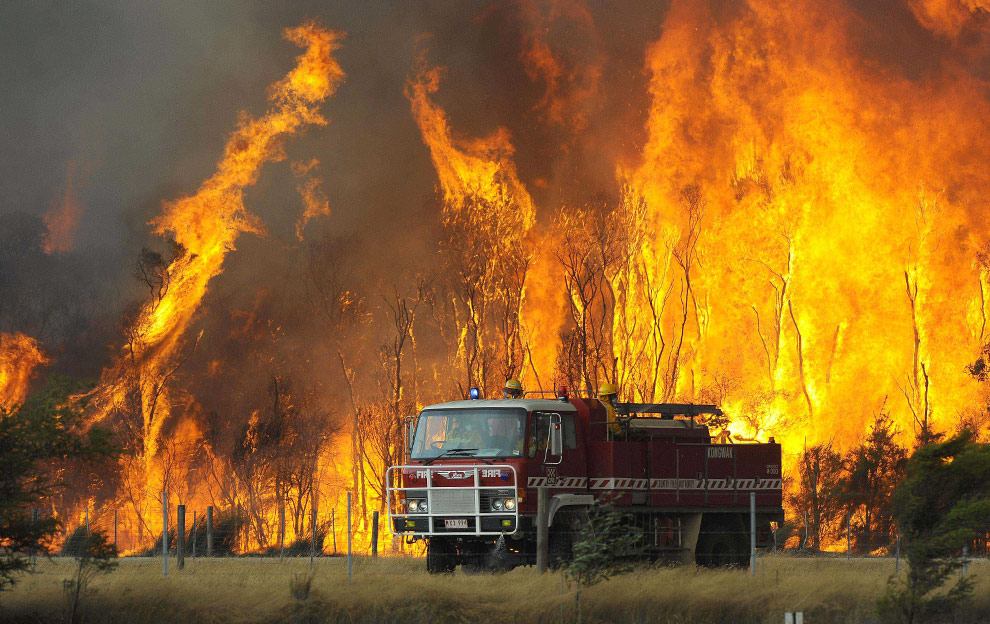 |
| A firetruck retreat in face of raging flames |
By Matt Siegel, The New York Times, January 9, 2013
SYDNEY, Australia —
Bush fires raging across some of the most populous parts of Australia — feeding off widespread drought
conditions and high winds — pushed firefighters to their limits and residents
to their wits’ end on Wednesday as meteorologists tracked the country’s hottest
spring and summer on record into uncharted territory.
Related
Firefighters
battled a grass fire in Oura, near Wagga Wagga, Australia, on Tuesday. On
Monday, Australia’s hottest day on record, the national average was 104.59
degrees.
Four months of record-breaking temperatures stretching back to
September 2012 have produced what the government says are “catastrophic” fire
conditions along the eastern and southeastern coasts of the country, where the
majority of Australians live.
Data analyzed on Wednesday by the government Bureau of Meteorology
indicated that national heat records had again been set. The average temperature
across the country on Tuesday was the highest since statistics began being kept
in 1911, at 40 degrees Celsius (104 degrees Fahrenheit), exceeding a mark set
only the day before. Meteorologists have had to add two new color bands to
their forecast maps, extending their range up to 129 degrees Fahrenheit.
“From this national perspective, one might say this is the largest
heat event in the country’s recorded history,” said David Jones, manager of
climate monitoring prediction at the Bureau of Meteorology. Firefighters were
struggling to contain huge bushfires in Australia’s most populous state, New
South Wales, which have scorched around 500 square miles of forest and farmland
since Tuesday. Fires on the island state of Tasmania off the country’s southern
coast have destroyed more than 300 square miles since Friday.
No confirmed deaths have been reported in connection with the fires,
but about 100 people have been unaccounted for since a fire destroyed around 90
homes in Dunalley, Tasmania, last week. State agricultural officials say that
tens of thousands of cattle and sheep are believed to have been killed in the
fires, which have torn through some of the country’s most productive
agricultural and farming regions.
Though the searing heat moderated a bit in some coastal areas on
Wednesday, the government warned that the very hot air mass that blistered
Sydney earlier in the week was moving up the eastern seaboard and would soon
affect Brisbane, Australia’s third-largest city.
The fires have grown so large that they are plainly visible in
photographs taken from the International Space Station on Tuesday and published by NASA. The intensity of the
bushfires and the unrelenting heat prompted some climate scientists to decry
what they see as public indifference to man-made climate change, which is widely seen as leading
to more frequent extreme weather.
“Those of us who spend our days trawling — and contributing to — the
scientific literature on climate change are becoming increasingly gloomy about
the future of human civilization,” Elizabeth Hanna, a researcher at the
Australian National University in Canberra, told The Sydney Morning Herald. “We
are well past the time of niceties, of avoiding the dire nature of what is
unfolding, and politely trying not to scare the public.”
Dr. Jones, the government climate scientist, echoed that opinion.
“This event is turning out to be hotter, more spatially expansive and
the duration is quite remarkable,” he said in an interview. “And that suggests
climate change.”
At least 141 separate fires were burning in New South Wales on
Wednesday, 31 of them out of control. The deputy commissioner of the state’s
Rural Fire Service, Rob Rogers, told reporters that it was a bad sign that the
fires could not be contained during the brief drop in temperatures.
“We’ve got a huge swath of New South Wales that potentially is going
to get new fires again this afternoon,” Mr. Rogers said. “It will be an
absolute battle to get containment on most of those fires before the return of
the hot weather on the weekend.”
Tuesday’s high added to a growing list of records set during this
extended heat wave, including the first time the country has recorded seven
consecutive days of temperatures above 39 degrees Celsius (102 degrees
Fahrenheit) and eight straight days to start the year that were among the 20
hottest on record. And there is little prospect of imminent relief.
“We
expect it to stay very hot across inland Australia for the next week,” Dr.
Jones said. “Beyond that, it’s hard to say.”
No comments:
Post a Comment